Subtraction worksheets for kindergarten PDF are designed to introduce young learners to basic math concepts through engaging activities․ These worksheets use visual aids and simple problems to help children understand subtraction․ They are perfect for developing foundational skills and making learning fun and interactive for kindergarten students․

Benefits of Using Subtraction Worksheets for Kindergarten
Subtraction worksheets for kindergarten PDF offer numerous benefits, including enhancing problem-solving skills and building a strong math foundation․ They promote cognitive development, improve concentration, and make learning enjoyable․ These resources help children grasp basic subtraction concepts through engaging and interactive exercises tailored to their learning level․
Developing Problem-Solving Skills
Subtraction worksheets designed for kindergarten play a crucial role in fostering problem-solving abilities among young learners․ These worksheets introduce children to basic subtraction concepts through engaging activities that encourage critical thinking․ By using visual aids like blocks, counters, or pictures, children can physically manipulate objects to understand how subtraction works․ This hands-on approach helps them develop logic and reasoning skills, as they learn to identify the difference between quantities․ Simple, age-appropriate problems allow kindergarteners to practice subtraction in a structured yet fun manner, building their confidence and laying the groundwork for more complex math skills in the future․
Building a Foundation in Mathematics

Subtraction worksheets for kindergarten PDF are essential tools for laying the groundwork in mathematics․ They introduce young learners to the concept of taking away objects from a set, which is fundamental for understanding subtraction․ By using visual aids such as blocks, counters, or pictures, these worksheets help children visualize numbers and their relationships․ This hands-on approach makes abstract math concepts more tangible and easier to grasp for kindergarten students․
The worksheets typically feature simple, age-appropriate problems that involve subtracting small numbers․ For example, questions like “If I have 5 apples and I take away 2, how many apples are left?” help children understand the basic idea of subtraction․ The use of familiar objects and scenarios makes learning relatable and engaging․ Over time, as children practice these problems, they develop a stronger understanding of number relationships and basic arithmetic operations․
Moreover, these worksheets help children recognize patterns and understand the structure of math problems․ They encourage learners to count backward, which reinforces their knowledge of number sequences․ By mastering these foundational skills, kindergarteners build a solid base for more complex math concepts in the future․ Subtraction worksheets for kindergarten PDF are, therefore, a valuable resource for teachers and parents aiming to provide children with a strong mathematical foundation․
Enhancing Cognitive Development
Subtraction worksheets for kindergarten PDF play a crucial role in enhancing cognitive development by engaging young learners in activities that promote problem-solving and critical thinking․ These worksheets introduce children to the concept of subtraction through visual and interactive exercises, helping them understand how to manipulate numbers and objects․ By using physical objects or visual aids, such as blocks or counters, children can experiment with taking away items and observing the results․ This hands-on approach fosters spatial reasoning and logical thinking, essential skills for overall cognitive growth․
Engaging in subtraction activities also encourages active learning, as children are required to participate in solving problems․ This interaction stimulates their motor skills and hand-eye coordination, particularly when worksheets involve drawing or counting objects․ The repetitive nature of practice problems helps reinforce memory and improves concentration, which are vital for cognitive development․ Moreover, subtraction worksheets introduce children to the concept of cause-and-effect relationships, as they see how removing objects affects the total count․
By incorporating these activities into their learning routine, children develop a stronger understanding of number relationships and logical reasoning․ This foundation not only enhances their mathematical abilities but also supports overall brain development, preparing them for more complex problem-solving tasks in the future․ Subtraction worksheets for kindergarten PDF are, therefore, a valuable tool for fostering cognitive growth in young learners․

Teaching Methods and Activities for Introducing Subtraction
Engage young learners with interactive activities like using physical objects, visual aids, and hands-on tasks to introduce subtraction․ These methods make learning fun and accessible, helping children grasp the concept through play and collaboration․
Using Physical Objects in Lessons
Using physical objects is a highly effective way to introduce subtraction to kindergarten students․ By incorporating tangible items like blocks, counters, or toys, children can visually represent and manipulate quantities, making abstract concepts more concrete․ This hands-on approach allows students to see the process of “taking away” and understand the relationship between numbers․ For example, if a child has 5 blocks and removes 2, they can count the remaining 3, reinforcing the concept of subtraction․ This method also encourages active participation, making learning engaging and fun․ Teachers can use everyday objects to create simple subtraction scenarios, such as taking away apples from a basket or removing cars from a row․ This tactile learning experience helps children develop problem-solving skills and builds a strong foundation for math․ Additionally, physical objects provide immediate feedback, allowing children to see the results of their actions and correct any misunderstandings․ This interactive method is particularly beneficial for young learners, as it aligns with their natural curiosity and tendency to explore through play․ By connecting physical objects to subtraction, educators can create meaningful and memorable lessons that support early math development․
Incorporating Visual Aids for Better Understanding
Incorporating visual aids into subtraction worksheets for kindergarten PDF is a powerful way to help young learners grasp mathematical concepts․ Visual aids such as number lines, images, and diagrams provide a concrete representation of subtraction, making it easier for children to understand the idea of “taking away․” For example, using pictures of objects like fruits or toys allows children to visually count and subtract, reinforcing their understanding of the concept․ Number lines are particularly effective, as they help children see the relationship between numbers and how subtraction moves them backward on the line․
- Visual aids like base-ten blocks or counting bears can be used to demonstrate subtraction in a hands-on way․
- Images of real-world scenarios, such as removing items from a set, make the concept relatable and engaging․
- Diagrams and charts can break down the subtraction process into clear, manageable steps․
By integrating visual aids into subtraction worksheets, educators can cater to the natural learning style of kindergarteners, who often learn best through observation and interaction․ These tools not only enhance understanding but also make learning subtraction a fun and engaging experience․ Visual aids also help children connect abstract numbers to tangible objects, building a strong foundation for future math skills․
Engaging Hands-On Activities
Engaging hands-on activities are a cornerstone of effective subtraction worksheets for kindergarten PDF․ These activities allow children to interact with physical objects, making the concept of subtraction tangible and relatable․ For example, using counting bears, blocks, or other manipulatives enables children to visually represent and solve subtraction problems․ This approach helps kindergarteners develop a concrete understanding of “taking away” by seeing the immediate results of their actions․
- Hands-on activities, such as removing objects from a set, help children grasp the concept of subtraction through direct experience․
- Using real-world scenarios, like taking away toys from a group, makes subtraction relevant and fun for young learners․
- Interactive games, such as rolling dice and subtracting numbers, can be incorporated into worksheets to make learning dynamic and engaging․
By combining physical manipulatives with visual guides, subtraction worksheets for kindergarten PDF provide a comprehensive learning experience․ These activities not only enhance problem-solving skills but also foster a love for mathematics at an early age․ Hands-on learning is particularly effective for kindergarteners, as it aligns with their natural curiosity and desire to explore the world through touch and interaction․

Structure of Effective Subtraction Worksheets

Effective subtraction worksheets for kindergarten PDF feature a simple, clear layout with engaging visuals and step-by-step problem presentation․ They incorporate visual aids like number lines or counters to help children understand subtraction concepts․ The structure ensures problems are introduced gradually, making learning accessible and enjoyable for young students․
Simple and Clear Layout

A simple and clear layout is essential for subtraction worksheets designed for kindergarten students; This ensures that young learners can focus on the task without being overwhelmed by clutter or complex designs․ Worksheets should feature large, easy-to-read fonts and ample spacing between problems to prevent confusion․
Visual aids, such as number lines or counters, are often incorporated to help children visualize the subtraction process․ These tools make abstract concepts more tangible and engaging․ Additionally, worksheets should avoid unnecessary decorations that might distract from the learning objective․
Each problem should be presented in a logical sequence, starting with basic subtraction facts and gradually introducing slightly more complex scenarios․ This progression helps build confidence and skills step by step․ The use of images or objects to represent numbers further enhances understanding, making the worksheets more relatable for young children․
Clear instructions and examples are also crucial․ Including visual examples, such as circles or blocks to be crossed out or counted, provides a hands-on approach to learning subtraction․ This method aligns with how kindergarten students naturally learn through play and exploration․
By maintaining a simple and organized structure, these worksheets ensure that children can grasp subtraction concepts without feeling frustrated․ The focus remains on foundational skills, preparing them for more advanced math in the future․
Engaging Visuals to Maintain Interest
Engaging visuals are a cornerstone of effective subtraction worksheets for kindergarten students․ These elements help maintain young learners’ interest and make the learning process enjoyable․ Worksheets often feature colorful illustrations, such as cartoons, animals, or real-life objects, to capture children’s attention and create a positive association with math․
Visual representations of numbers, like blocks, circles, or dots, are commonly used to demonstrate subtraction concepts․ For example, a worksheet might show a group of apples with a certain number circled or crossed out, allowing children to visually subtract and find the answer․ These images make abstract ideas more concrete and relatable for young minds․
Some worksheets incorporate interactive elements, such as “color-by-subtraction” activities, where children color specific objects based on the result of a subtraction problem․ This hands-on approach not only reinforces math skills but also fosters creativity and engagement․ The use of familiar themes, like pets, toys, or seasonal items, further personalizes the learning experience․
By integrating engaging visuals, subtraction worksheets cater to kindergarten students’ natural curiosity and preference for visual learning․ This approach helps children stay focused, builds their confidence, and makes the process of learning subtraction both fun and memorable․
Step-by-Step Problem Presentation
Step-by-step problem presentation is a key feature of effective subtraction worksheets for kindergarten students․ These worksheets are designed to break down subtraction concepts into simple, manageable parts, allowing young learners to grasp the fundamentals without feeling overwhelmed․ By presenting problems in a sequential manner, children can follow along easily and understand how subtraction works․
Many worksheets begin with basic scenarios, such as showing a set of objects and asking children to identify how many are left after a certain number is taken away․ For example, a worksheet might display five circles and ask, “If you take away two circles, how many are left?” This visual approach helps children connect the abstract concept of subtraction with concrete objects they can see and count․
The step-by-step format often includes visual cues, such as arrows or numbered steps, to guide children through the problem-solving process․ This not only helps build their problem-solving skills but also encourages logical thinking․ Over time, as children become more confident, the worksheets may introduce slightly more complex scenarios, such as subtracting larger numbers or solving word problems․
By presenting problems in a clear, structured way, subtraction worksheets help kindergarteners develop a strong foundation in math․ This method ensures that learning subtraction is both enjoyable and effective, preparing children for more advanced math concepts in the future․

Age-Appropriate Content in Worksheets

Subtraction worksheets for kindergarten are tailored to young learners’ developmental levels, featuring simple, engaging activities that introduce basic math concepts․ They use relatable visuals and real-life scenarios to make learning subtraction fun and accessible, ensuring children build confidence in their math skills from an early age․
Suitability for Kindergarten Level
Subtraction worksheets designed for kindergarten are specifically tailored to meet the developmental needs of young learners․ They feature simple, engaging activities that introduce basic subtraction concepts through the use of visual aids, such as pictures or objects, making it easier for children to grasp the idea of “taking away․” These worksheets avoid complex language or advanced math, ensuring that the content is accessible and non-intimidating for 4- to 6-year-olds․ The problems are often presented in relatable scenarios, such as counting toys or fruit, which helps children connect the math to their everyday experiences․ Additionally, the worksheets are designed to be short and manageable, preventing overwhelm and keeping young learners focused․ By using large, clear fonts and colorful visuals, these resources cater to the attention span and learning style of kindergarteners․ They also provide opportunities for children to practice fine motor skills through tracing or drawing, making the learning process interactive and enjoyable․ Overall, subtraction worksheets for kindergarten are a valuable tool for introducing math in a way that is both age-appropriate and engaging․
These worksheets are carefully designed to align with early childhood education standards, ensuring they are both educational and fun․ They serve as a stepping stone for building a strong foundation in math, preparing children for more complex concepts in the years to come․
Gradual Progression of Skills
Subtraction worksheets for kindergarten PDF are designed to promote a gradual progression of skills, allowing young learners to build confidence and understanding at their own pace․ These worksheets typically start with simple subtraction concepts, such as taking away one or two objects from a small set, and gradually introduce more complex problems as the child progresses․ For example, early worksheets might focus on single-digit subtraction using visual aids like pictures or counters, while later sheets introduce basic number sentences (e․g․, 5 ⎯ 2 = ___) and word problems․ This step-by-step approach ensures that children are not overwhelmed and can master one concept before moving on to the next․

The progression also incorporates activities that reinforce previous learning, such as counting backward, recognizing “one less” or “two less,” and understanding the relationship between addition and subtraction․ Worksheets may include exercises where children match problems to solutions, complete simple arithmetic, or draw objects to represent subtraction scenarios․ This gradual progression helps children develop a strong foundation in math, making it easier for them to tackle more advanced concepts in the future․
By offering a variety of exercises and activities, subtraction worksheets for kindergarten PDF ensure that learning is both engaging and effective․ The structured progression of skills helps children feel a sense of accomplishment as they grow more proficient in subtraction․